Policies
Two fields on the sales order table (and the forecast table for the enterprise version) configure what deliveries are being accepted by the customer:

Minimum shipment
A.Defines the minimum delivery size accepted by the customer.
If the minimum delivery size is set equal to the demand quantity, the customer only accepts a single delivery in full.
If the minimum delivery size is smaller than the demand quantity, the customer will accept partial shipments.
If the minimum delivery size is greater than the demand quantity, the customer will receive more than he actually ordered (eg order 2 units and get shipped the smallest box with 10 units).
Maximum lateness
B.Determines the maximum delay the customer will accept before cancelling his or her order. When the demand isn’t feasible within this delay frePPLe will plan the order short.
In some businesses demand that can’t be met on time is lost - the customer will simply buy the product from your competitor. Another usage is for forecasted demand - typically you don’t want to plan them later than the demand bucket.
Check this feature on a live example
Download an Excel spreadsheet with the data for this example
In this example we have 6 identical items, served from inventory and with a simple stock replenishment operation. Each item has a single demand with a different delivery policy.
The demands are delivered differently according to their policies.

Demands 1, 2 and 3 are allowed to be planned late, and we see late deliveries 1.
For demand 1 we also see a partial shipment at the requested date.
Demands 4, 5 and 6 aren’t allowed to be planned late.
Only for demand 4 we can plan a partial shipment 2. Orders 5 and 6 remain unplanned.
